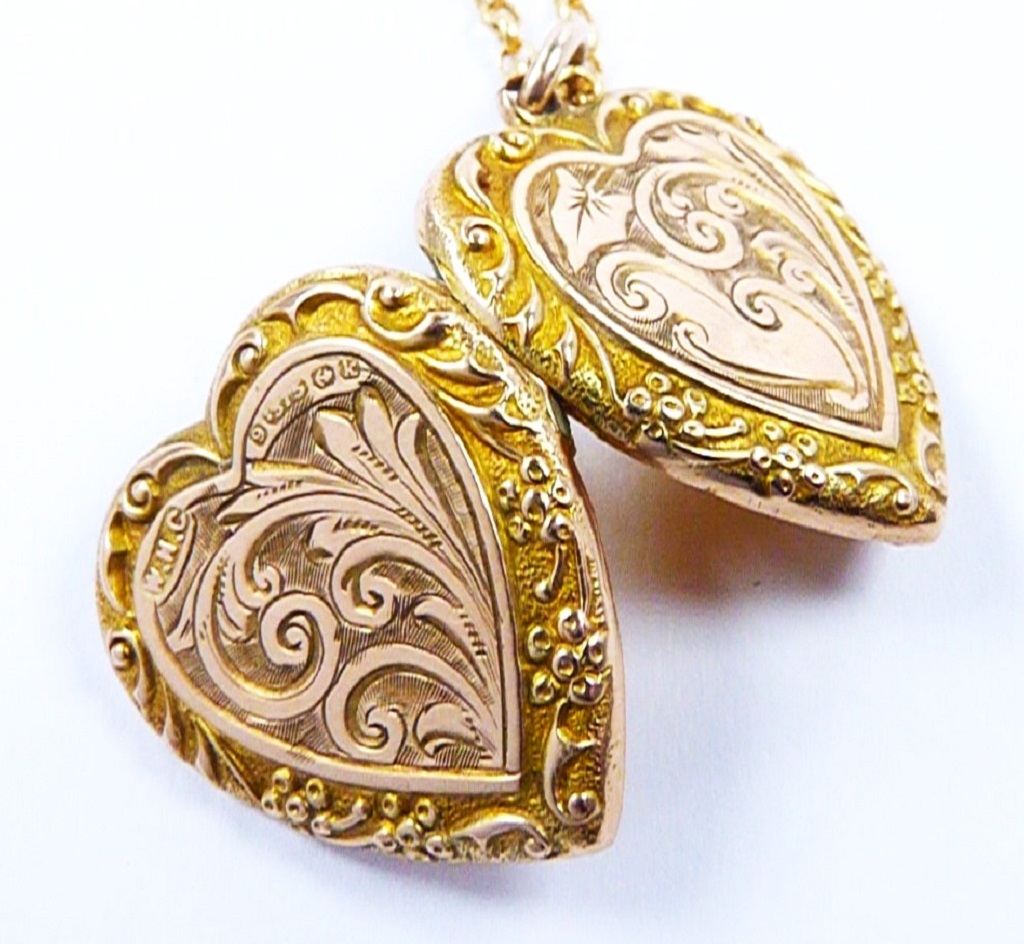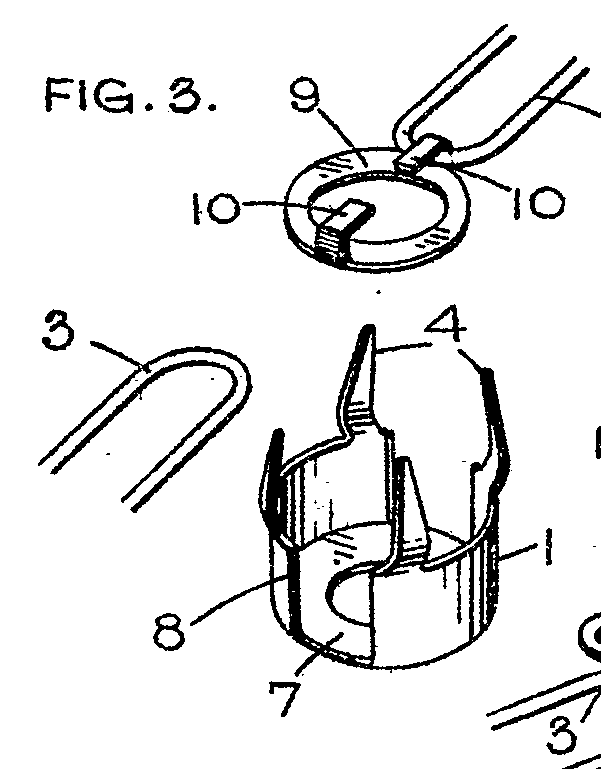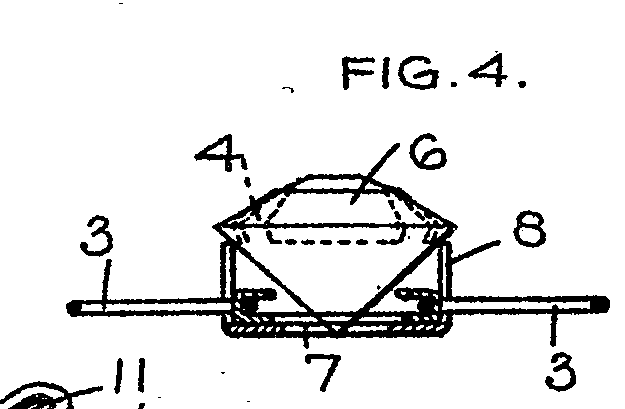The trade advertisement above shows that the firm was patenting their inventions from the Victorian era.

EDWARDIAN ERA 9 CARAT GOLD LOCKET
This superb fully hallmarked gold Art Nouveau locket was crafted by W. H. Collins in 1909.

This solid gold Edwardian keepsake locket was assayed* (tested*) for gold purity at Birmingham Assay Office.
Fashioned in the shape of a heart with embossed edges which depict scrollwork and lobular floral motifs, this piece has a timeless quality.
Each side is fitted with heart shaped panels. Each of the heart shaped panels is decorated with the most deliciously Art Nouveau embellishments. The anterior surface depicts florid acanthus and ivy leaves and a scroll which echoes the sinuous curves of plants. The other heart shaped panel is ornamented with acanthus leaves.
The original portrait protectors and frames are present.
As well as the heart shapes which convey sentiments of deep love and respect, acanthus leaves symbolise everlasting life. The emblem of the scroll indicates the virtue of wisdom.
This locket necklace gleams in the light and possesses a mesmerising quality.
FULL SETS OF HALLMARKS
W.H.C - W. H. Collins maker’s mark
9 - denoting 9 carat gold
.375 - the decimal value of 9 carat gold
Anchor - representing Birmingham Assay Office
Lowercase k in this font within this style of cartouche 1909
The firm is especially well known for their superb fully hallmarked gold lockets and jewellery.
EXCELDA WORKS
The image shown above is the premises of W. H. Collins & Co. Ltd. which was named the Excelda Works. The manufacturing premises were located at Rookery Road, Handsworth, Birmingham. The Excelda Works were completed in 1920. This building replaced the firm's former workshops at Great King Street. The photograph dates to the early 1960s. Some of the impressive range of luxury goods crafted by this company are listed in an advertisement which stated:
ATTRACTIVE DESIGNS IN SUPERLATIVE FINISH
The trademark “PRI AUR” covers a wide range of fancy jewellery
in 9ct gold, sterling silver and rolled gold.
EARRINGS
BROOCHES
CROSSES
NECKLETS
BRACELETS
CHARMS
Also a wide range of
GIFTS FOR BABY
such as Rattles and Spoon & Pusher sets
In H M* silver and EPNS**
PRI AUR
Manufactured by W. H. Collins
Excelda Works
ROOKERY
Pri Aur Fancy Jewellery & Life-Long Pencils
HM* represents hallmarked.
EPNS** is an acronym for electroplated nickel silver which is an alloy of nickel, copper, and zinc that is covered with a layer of pure silver in an electrochemical process.
PATENT 311897
Walter Henry Collins patent 311897 was accepted on May 23 1929.
His description of his invention is included below:
1. A piece of jewellery comprising a plurality of loop like members or elements ill adapted to be connected together by links, wherein the elements are provided with holes or slots in their walls and are also provided with a tongue or finger adjacent to each hole or slot so that after the end of a link, comprising a closed loop or a member having a closed eye or loop at each end, has been placed through a hole or slot, it can be retained by passing the tongue or finger through the link on the inside of the loop like member or element.
2. A piece of jewellery according to Claim 1, wherein the elements are formed as rings or loops and have the holes or slots located at their ends, and the fingers or tongues are integral with the elements at one edge adjacent to each hole and are long enough to extend across and beyond the edges of said holes or slots in the elements 3. A piece of jewellery according to Claim 1 or 2, wherein the said holes are wider at the ends than at the centre.
4. A piece of jewellery having its elements secured substantially as described with reference to the accompanying drawings.
Dated the 20th day of December, 1928.
FORRESTER, KETLEY & Co., Chartered Patent Agents, Central House, 75, New Street, Birmingham, and Jessel Chambers, 88/90, Chancery Lane, London, W.C. 2.
Redhill: Printed for His Majesty's Stationery Office, by Love & Malcomson, Ltd.-1929.
PATENT 348539
The necklace comprises a number of elements 1 connected together and to other elements 2 by links 3.
The links 3 are arranged in horizontal planes, that is, substantially parallel to the surface upon which the under sides of the elements 1 and 2 are adapted to rest.


Each of the elements 1 is of cylindrical cup-like form as shown clearly in Figures 3 and 4
and is provided with a number of claws 4 by which the stone 6 is retained in position in the element.
The element has a horizontal flange 7 on its lower side and is provided at diametrically opposite points with openings 8.
Within the element 1 is placed a washer or coupling member 9 which may be in the form of a pressing
having diametrically oppositely disposed hooks or ears 10 upon which are mounted the links 3.
The stone 6 is placed in the element 1 so that it rests on the flange.
PATENT 348539
Walter Henry Collins Patent Complete Accepted May 12 1931
PATENT 419699
Walter Henry Collins Patent Complete Accepted November 16 1934
These beautiful propeller pencils*** were crafted from sterling silver and presented in stylish cream boxes.
The lids are signed with the brand name Life-Long in red print.
The interior box lid is stamped with the following:
"Life-Long" Propelling Pencil
MADE IN ENGLAND STERLING SILVER
***The inventor describes his pencils as propeller pencils while other company information lists them as propelling pencils.
The pencils were stamped STERLING SILVER “Life-Long” at the top of the pen.
In 1946-1947 Goldsmiths Journal advertisements show that this firm was still manufacturing propelling pencils for wholesale or export.
PATENT 483401
W. H. Collins & Company Limited Patent Complete Accepted April 20 1934
Figure 1 is the face view of a brooch in which the setting is constructed in accordance with the present invention.
Figure 2 is a perspective view of part of the setting, showing the stones and setting member separated from the mount.
Figure 3 is a section to an enlarged scale on the line 3–3 of Figure 1.
Figure 4 is the view corresponding to Figure 2 and illustrating the invention as applied to a setting for a finger-ring.
Figure 5 corresponds to Figures 2 and 4 and shows the application of the invention to a setting having a cup-like mount.
Figure 6 is a transverse sectional view of the setting member and central mount shown in Figure 5.
The next patent drawing depicts one of the company’s crosses.
PATENT 505295
W. H. Collins & Company Limited Patent Complete Accepted May 9 1939
There is very little information about the company but we do know that it was still trading in the 1950s because on February 2 1952 an application was made to patent Improvements in jewellery.
More fully hallmarked antique gold jewellery.
Please note that although we spend many hours each week updating or compiling new work for our historical blog section which is free to view, we do not offer an appraisal, identification, valuation or dating service to members of the public.
However, each purchase from our store is shipped with a lavishly illustrated history which dates the item and details the history of the item and that of the maker.
Sources:
Patent Office
silvercollection.it
Google
Grace's Guide

